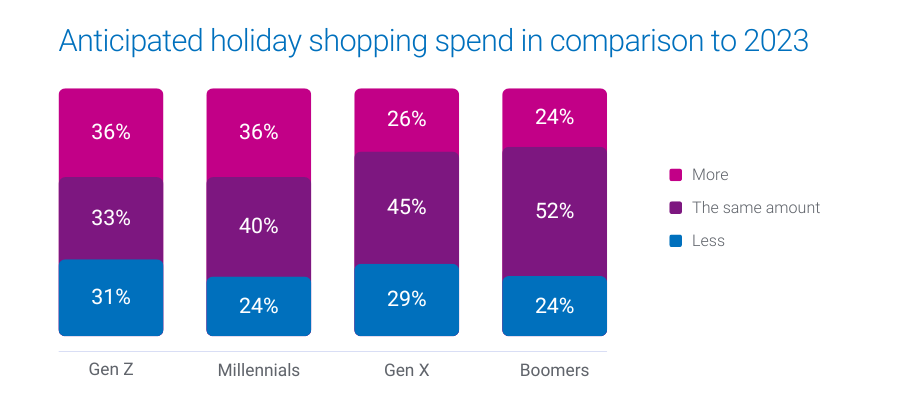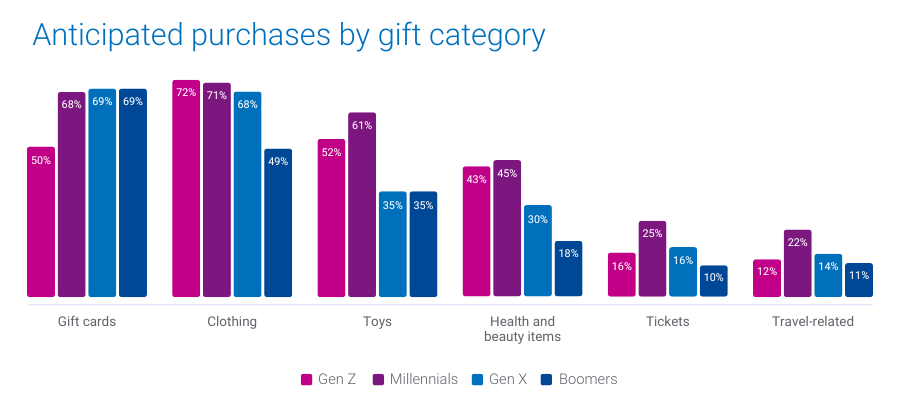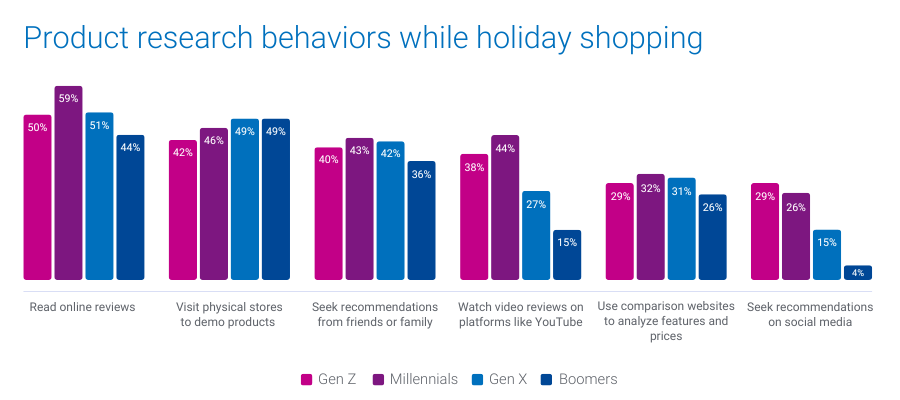
The holiday season is almost here, and knowing how each generation plans to shop can give your holiday advertising campaigns the edge you need. Our recent survey of 1,000 U.S. consumers reveals 2024 holiday shopping trends for each generation and key insights into their anticipated spending levels, preferred shopping categories, and how they look for gift ideas.
In this blog post, we’ll explore three 2024 holiday shopping trends across generations:
- Projected consumer spending
- Top categories on shoppers’ lists
- Preferred channels for researching gifts
1. Projected consumer spending
Over 1 in 3 Gen Z and Millennials are gearing up to increase their holiday budgets this year, while Gen X and Boomers are likelier to stick to last year’s budget.
- 36% of Millennials and Gen Z plan to spend more this holiday season
- 45% of Gen X and 52% of Boomers expect their spending to remain consistent with last year

What this means for marketers
These insights highlight the importance of tailoring your messaging. For Gen Z and Millennials, emphasize value and unique offerings that justify increased spending. For Gen X and Boomers, focus on trust and reliability, reinforcing their confidence in your brand.
How Experian can help you target these audiences
Experian’s custom and syndicated audience segments, including Holiday Shopper High Spenders and Holiday Shopper Moderate Spenders, enable you to connect with these diverse consumer groups. Our audiences are available on-the-shelf of leading ad platforms to help you reach people across social, TV, and mobile.
The election effect
U.S. holiday retail sales saw 4.1% YoY growth in 2016 and 8.3% YoY growth in 2020 following presidential elections. There’s a chance that holiday spending increases after the 2024 election, regardless of the outcome. Experian has 240+ politically relevant audiences that you can activate across major ad platforms ahead of the upcoming election.
2. Top categories on shoppers’ lists
Different generations have distinct preferences when it comes to what they plan to buy. Gift cards top the list for Gen X and Boomers, while Gen Z leans toward clothing. Millennials are looking to splurge on toys, electronics, and experiences.
- 69% of Boomers and Gen X plan to purchase gift cards
- 72% of Gen Z will buy clothing
- 45% of Millennials will buy health and beauty items
- 25% of Millennials will buy tickets and 22% of Millennials will buy experiences

What this means for marketers
Align your product offerings and promotions with each generation’s preferences to capture their attention. For example, highlighting versatile gift cards may resonate more with older generations, while showcasing trendy apparel and tech gadgets will appeal to younger consumers.
How Experian can help you target these shoppers
We offer audience segments like Holiday Shoppers: Apparel, Cosmetics & Beauty Spenders, and Toys Shoppers that you can activate to connect with consumers primed to purchase in these categories.
We recently released 19 new holiday shopping audiences we recommend targeting to drive engagement and conversions. Download our audience recommendations here.
3. Preferred channels for researching gift ideas
When it comes to finding the perfect gifts, Gen Z turns to social media, while Millennials prefer online reviews and video content. Boomers and Gen X are more inclined to visit physical stores for hands-on product evaluations.
- 29% of Gen Z and 26% of Millennials will look for gift ideas on social media
- 44% of Millennials will rely on video reviews and product demos on platforms like YouTube
- 49% of Gen X and Boomers plan to visit physical stores to evaluate products in person

What this means for marketers
Understanding where each generation looks for inspiration can guide your content and ad placement strategy. To engage Gen Z, focus on social media campaigns and influencer partnerships. For Millennials, consider investing in video content and reviews. For older generations, ensure your in-store experience is optimized to convert browsing into purchases.
How Experian can help you engage these shoppers
Our TrueTouchTM audiences can help you pair the perfect messaging styles with the right channels and calls to action. Our Social media channel and content engagement audiences can help you reach Gen Z who are likely to be active users on major social platforms and are Black Friday shoppers. For a full list of Experian’s syndicated audiences and activation destinations, download our syndicated audiences guide.
Download our report for five 2024 holiday shopping trends by generation
Understanding 2024 holiday shopping trends by generation can help you tailor your targeting, messaging, media planning, and creative based on the generation you’re targeting.
In addition to the insights covered here, download our 2024 Holiday spending trends and insights report to learn:
- When consumers plan to shop (hint: they’re already shopping)
- Where they plan to shop (online vs. in-store)
Download our full report to access all five of our predictions by generation, so you can address the diverse needs of this year’s holiday shoppers.
When you work with Experian for your holiday shopping campaigns, you’re getting:
- Accurate consumer insights: Better understand your customers’ behavioral and demographic attributes with our #1 ranked data covering the full U.S. population.
- Signal-agnostic identity solutions: Our deep understanding of people in the offline and digital worlds provides you with a persistent linkage of personally identifiable information (PII) data and digital IDs, ensuring you accurate cross-device targeting, addressability and measurement.
- Secure connectivity: Bring data and identity to life in a way that meets your needs by securely sharing data between partners, utilizing the integrations we have across the ecosystem, and using our marketing data in flexible ways.
Make the most of this holiday shopping season with Experian. Contact us today to get started.
Source
Online survey conducted in June, 2024 among n=1,000 U.S. adults 18+. Sample balanced to look like the general population on key demographics (age, gender, household income, ethnicity, and region).
Latest posts

If you live in an early primary or caucus state, you’ve probably already had your fill of political advertising. According to The Washington Post, politicians and political groups spent more than $23 million on campaign television ads as of December 1, 2011. With record ad spending predicted for the 2012 election, the rest of the nation will soon be bombarded with television ads “approved by” politicians from the left, right and the center of the political spectrum. Candidates and those groups that support them need to know where to allocate their ad dollars to either connect with their base or reach swing voters. Experian Simmons analyzed the viewing audiences of over 600 broadcast, cable and syndicated TV programs that were measured in our most recent National Consumer Study in order to pinpoint opportunities for politicians to reach partisans and middle of the road voters. This analysis has already gathered the attention of major media outlets, including Entertainment Weekly, The Washington Post, AOL, Huffington Post and more. Below are the entertainment and news programs that score the highest concentration of liberal Democrats among their viewers, Conservative Republicans and Middle-of-the-Road Voters registered with any party. Be sure to check out our free 2011 PoliticalPersonas report in which Experian Simmons delivers the mindset of the American voter, including attitudes, brand preferences and their penchant for social media. You can also check out a similar analysis of TV preferences of political partisans that we conducted last year here and here.

Social media continues to be one of the fastest growing industries online. Between September 2010 and September 2011 visits to Social Networks and Forums have increased by nearly 11% and, if you saw my Internet clock blog last month, social media accounts for nearly a quarter of all time spent online. But when are people engaging with social media the most? We took a look at the UK Internet visits to the Social Networks and Forums category each month between 2009 and 2011. We then averaged those visits across the months to see the seasonal trends with social media. What this shows is that social media usage is at its lowest at the beginning of the year and climbs throughout the course of the year towards a peak in December. Over the last three years December has always seen the peak of online visits and in fact last Christmas Day Facebook overtook Google for the first time ever in terms of UK Internet visits. We know that Christmas is a very social time and a time for sharing messages with loved ones, friends and family, so the increased visits to social networks during December is to be expected. More generally, what this graph shows is that social media observes two seasonal trends. The first is an early summer peak in visits in June, before a decline in visits in July and August. This seasonal dip in July and August can be explained by summer holidays where people are more likely to go abroad and therefore less likely to be using social networks. The second seasonal trend is a recovery in visits in September and October before a yearly peak at Christmas. With students starting university terms, kids going back to school, and the working population returning from holiday this would account for the increased interaction in September and October before the Christmas surge. In particular what we’ve seen in September data is a resurgence in market share of visits to Facebook, which bounced back after the summer dip to account for nearly 52% of all visits to a social network. The message here for brands who want to capitalise on social media traffic is to start implementing their social strategy now rather than waiting for Christmas. As October is the second busiest month of the year for social media visits we are expecting over 800 million hours to be spent on social networks this month, which represents a huge opportunity to engage with new and existing customers online. Follow Hitwise UK on Twitter.

Marketing by mobile device is now as popular as ever as retailers send shoppers text messages with special offers and sales. More and more companies are also offering their own phone apps so customers can search for product information and deals on the go. With more than 80 million mobile internet users in the United States, retailers can really benefit from this communication channel. One perk for shoppers is that they no longer have to save and print out coupons from emails! Through their mobile phones, shoppers can receive texts about sales and coupons as they enter stores. They can keep track of their favorite stores and make a purchase anywhere/anytime. One perk for shoppers is that they no longer have to save and print out coupons from emails! All they have to do is show the coupon on their phone at the point of purchase to redeem their coupon. With “QR” bar codes or quick response codes directly on coupons on your phone, savings can be redeemed on the spot. While many people don’t know yet that they can use QR codes on a mobile device, retailers have only begun to take advantage of this technology and more customers are now able to scan items in a store and pay for it using their mobile phones. While it’s just the beginning of a new era, mobile marketing is taking us by storm and now is the perfect time to put this trend into effect.